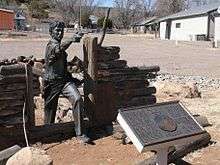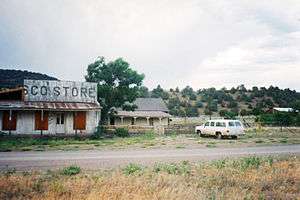Elfego Baca
| Elfego Baca | |
|---|---|
 Monument to Elfego Baca | |
| Born |
February 10, 1865 Socorro, New Mexico |
| Died |
August 27, 1945 (aged 80) Albuquerque, New Mexico |
| Occupation | Gunfighter, sheriff, lawyer and politician |
| Political party | Republican Party |
Elfego Baca (February 10, 1865 – August 27, 1945) was a gunman, lawman, lawyer, and politician in the closing days of the American wild west. Baca was born in Socorro, New Mexico, just before the end of the American Civil War to Francisco and Juana Maria Baca. His family moved to Topeka, Kansas, when he was a young child. Upon his mother’s death in 1880, Baca returned with his father to Belen, New Mexico, where his father became a marshal.
In 1884, at age 19, Baca acquired some guns and became a deputy sheriff (whether through purchasing a badge or by being appointed is unclear) in Socorro County, New Mexico.
His goal in life was to be a peace officer. He wanted, he said, “the outlaws to hear my steps a block away.” Southwestern New Mexico at the time was still relatively sparsely settled cattle ranching country. Cowboys roamed the land and did as they pleased. They might come into a town, drink at the saloon, harass the locals, and then shoot up the town out of boredom. Baca meant to put an end to that.
Frisco Shootout

In October 1884, in the town of Middle San Francisco Plaza (now Reserve, New Mexico), Elfego Baca arrested a drunk cowboy named Charlie McCarty. Baca flashed his badge at McCarty and took Charlie's gun. McCarty's fellow cowboys tried to take him by force, but Baca resisted and opened fire on the cowboys, killing the horse of John Slaughter's foreman, which fell on him and killed him. Baca shot another cowboy in the knee. Subsequently, Justice of the Peace Ted White granted Charlie's freedom and summoned Bert Hearne, a rancher from Spur Lake Ranch, to bring Baca back to the Justice for questioning relating to what the Justice considered murder. After Baca refused to come out of the adobe jacal, Hearne broke down the door and ordered Baca to come out with his hands up. Soon after that, shots volleyed from the jacal and hit Hearne in the stomach, resulting in his death.
A standoff with the cowboys ensued. The number of cowboys that gathered has been disputed, with villagers at the scene reporting about forty present while Elfego himself later claimed there had been at least eighty. Allegedly, the cowboys fired more than 4,000 shots into the house, until the adobe building was full of holes. Incredibly, not one of the bullets struck Baca. (The floor of the home is said to have been slightly lower than ground level; thus Baca was able to escape injury.)
During the siege, Baca shot and killed four of his attackers and wounded eight others. After about 33 hours and roughly 4,000 rounds of open fire, the battle ended when Francisquito Naranjo persuaded Baca to surrender. In May 1885, Baca was charged with murder for the death of John Slaughter's foreman and Bert Hearne and was jailed awaiting trial. In August 1885, Baca was acquitted after the door of Armijo’s house was entered as evidence. It had more than 400 bullet holes in it. The incident became known as the Frisco Shootout. Purportedly, Baca's defense attorney had false documentation to prove Baca's legal deputization because Baca's biography suggests he deputized himself just before the arrest of Charlie McCarty.[1]
Law and order
Baca officially became the sheriff of Socorro County and secured indictments for the arrest of the area's lawbreakers. Instead of ordering his deputies to pursue the wanted men, he sent each of the accused a letter. It said, "I have a warrant here for your arrest. Please come in by March 15 and give yourself up. If you don’t, I’ll know you intend to resist arrest, and I will feel justified in shooting you on sight when I come after you." Most of the offenders turned themselves in voluntarily.
In 1888, Baca became a U.S. Marshal. He served for two years and then began studying law. In December 1894, he was admitted to the bar by Judge A.A. Freeman and briefly joined Freeman's Socorro law firm in February 1895.[2][3] He practiced law on San Antonio Street in El Paso between 1902 and 1904.
Political life
Baca held a succession of public offices, including county clerk, mayor and school superintendent of Socorro County and district attorney for Socorro and Sierra counties. In his book The Shooters, historian Leon Metz writes that “most reports say he was the best peace officer Socorro ever had.”
From 1913 to 1916, Baca served as the official U.S. representative of Victoriano Huerta's government during the Mexican Revolution. In April 1915, Baca was charged with criminal conspiracy for allegedly masterminding the November 1914 escape of Mexican general José Inés Salazar from the Albuquerque jail.[4] Successfully defended by the New Mexican lawyer and politician Octaviano Larrazolo, Baca's reputation grew among Southwestern residents.
When New Mexico became a state in 1912, Baca unsuccessfully ran for Congress as a Republican. Nevertheless, he remained a valued political figure because of his ability to turn out the vote among the Hispanic population. Working at times as a private detective, Baca also took a job as a bouncer in a casino across the border in Ciudad Juárez, Mexico.
Baca worked closely with New Mexico’s longtime Senator Bronson Cutting as a political investigator and wrote a weekly column in Spanish praising Cutting’s work on behalf of local Hispanics. Baca considered running for governor despite his declining health, but he failed to secure the Democratic Party’s nomination for district attorney in 1944.
Metz, his biographer, wrote: “Elfego was, and is, controversial. He drank too much; talked too much ... he had a weakness for wild women. He was often arrogant and, of course, he showed no compunction about killing people.” On his 75th birthday, Baca told the Albuquerque Tribune that as a lawyer he had defended 30 people charged with murder and that only one went to the penitentiary.
In July 1936, several years before his death, Janet Smith conducted an interview with Elfego Baca. Her notes can be found in the Library of Congress, Manuscript Division, WPA Federal Writers’ Project Collection. Baca told Smith, “I never wanted to kill anybody, but if a man had it in his mind to kill me, I made it my business to get him first.”
Legends
Another legend says that Baca stole a pistol from Pancho Villa and the angry Villa put a price of $30,000 on Baca’s head.[5]
One often-told story says that once when he was practicing law in Albuquerque, Baca received a telegram from a client in El Paso, Texas. "Need you at once," it said. "Have just been charged with murder," to which Baca is supposed to have responded with a telegram saying, "Leaving at once with three eyewitnesses."[6]
Walt Disney television series
In 1958, Walt Disney Studios released a television miniseries entitled The Nine Lives of Elfego Baca starring Robert Loggia in the title role.[7] Significant is the care Disney took to depict the famous siege in as authentic a manner as possible, given the known details.[7] Among those who appeared in the series were Skip Homeier, Raymond Bailey, and I. Stanford Jolley. Episodes of the series were later edited into a 1962 movie titled Elfego Baca: Six Gun Law.
The theme song's tag line was, "And the legend was that / Like el gato, "the cat" / Nine lives had Elfego Baca."
See also
References
- ↑ "Elfego Baca battles Anglo cowboys". www.history.com. December 1, 1884. Retrieved September 26, 2013.
- ↑ William A. Keleher, Memoirs, Episodes in New Mexico History, 1892-1969 (Sunstone Press, 2008), p. 179.
- ↑ "Judge A.A. Freeman," Old Abe Eagle, 28 February 1895, p. 1.
- ↑ Bryan, Howard Incredible Elfego Baca: Good Man, Bad Man of the Old West", p. 68-76
- ↑ Miller, Rod (1 May 2015). The Lost Frontier: Momentous Moments in the Old West You May Have Missed. Rowman & Littlefield. p. 207. ISBN 9781493015207.
- ↑ Howard Bryan, 'Incredible Elfego Baca' 1993, pg 3
- 1 2 "Elfago Baca". Legends: Outlaws & Lawmen. Boulder, Colorado USA: Active Interest Medua, Inc. June 2013. Special edition of American Cowboy magazine. Page 28: "Walt Disney, the only producer of 1950s TV Westerms to focus on minority issues, powerfully told the full story of Baca's career in a ten-episode mini-series for ABC between 1958-1960, starring Robert Loggia. The title The Nine Lives of Elfago Baca, played off the hero's nickname 'El Gato,' the cat."
External links
- Elfego Baca at Find a Grave
- The Nine Lives of Elfego Baca on IMDb
- UltimateDisney.com's Show/DVD Review of Elfego Baca
- Tribute to Elfego Baca in the U.S. House of Representatives, May 10, 1995
- Elfego Baca
- Interview with Elfego (Library of Congress)
- Borderlands
- Elfego Baca at 'Readers of The Purple Sage'
- Frisco, New Mexico, GhostTowns.com entry by Samuel W McWhorter.
- Elfego Baca & The “Frisco War”. Legends of America website.
- Elfego Baca Destined to Survive
- Elfego Baca Project